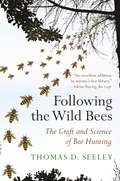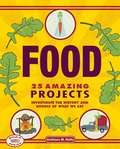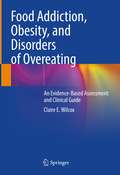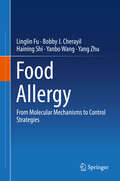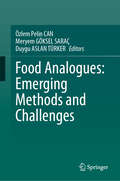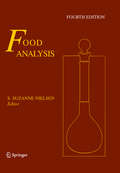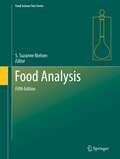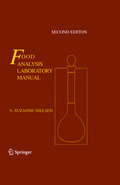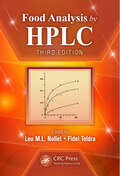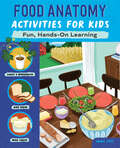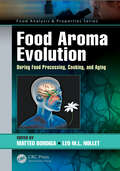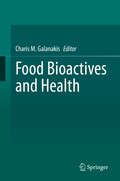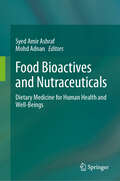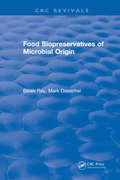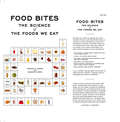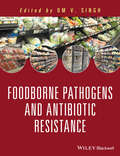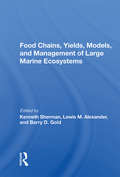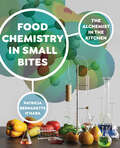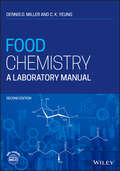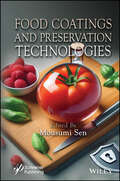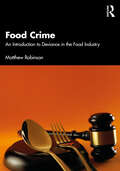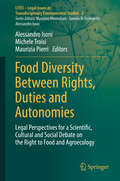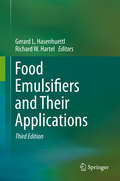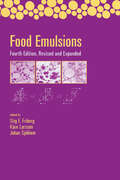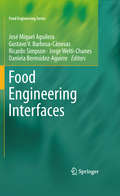- Table View
- List View
Following the Wild Bees: The Craft and Science of Bee Hunting
by Thomas D. SeeleyA how-to book on an exhilarating outdoor activity and a unique meditation on the pleasures of the natural worldFollowing the Wild Bees is a delightful foray into the pastime of bee hunting, an exhilarating outdoor activity that used to be practiced widely but which few people know about today. Weaving informative discussions of bee biology with colorful anecdotes, personal insights, and beautiful photos, Thomas Seeley describes the history and science behind this lost pastime and how anyone can do it. The bee hunter’s reward is a thrilling encounter with nature that challenges mind and body while also giving insights into the remarkable behavior of honey bees living in the wild. Whether you’re a bee enthusiast or just curious about the natural world, this book is the ideal companion for newcomers to bee hunting and a rare treat for armchair naturalists.
Food
by Farah Rizvi Kathleen M. ReillyFrom the minute life begins, food makes you strong, helps you grow, and gives you energy. But do you take that ham sandwich for granted? You might not give a lot of thought to where your food comes from, how it got to you, what's really in it, or what it does for you. Food: 25 Amazing Projects Investigate the History and Science of What We Eat gives kids some "food for thought" as they dive into exciting projects about the incredible world of food. Kids will have fun learning about all aspects of food in our daily lives-how vegetarians balance their diet, how some cultures rose and fell based on a single food source, the route from farm to market, how eating locally makes an impact, and much more.
Food Addiction, Obesity, and Disorders of Overeating: An Evidence-Based Assessment and Clinical Guide
by Claire E. WilcoxThis book is written for providers of broad training backgrounds, and aims to help those who care for people with EDs, overweight and obesity provide evidence-based care. The goal of the book is to provide these providers with a straightforward resource summarizing the current standard of care. However, it goes further by also introducing the concept of food addiction (FA) as a model to understand some forms of overeating. This book discusses the pros and cons of embracing FA and reviews the evidence for and against the validity and utility of FA. By doing so, the chapters convey a “middle ground” approach to help people with obesity, BED, and bulimia nervosa plus FA symptomatology who also want to lose weight. The text discusses FA by reviewing several of the main ongoing controversies associated with the construct. It reviews both the clinical and neuroscientific evidence that some individuals’ eating behavior mirrors that seen in substance use disorders (SUD), such as how their relationship with food appears to be “addictive”. Chapters also discuss how many of the mechanisms known to underlie SUDs appear to drive overeating in animal models and humans. Finally, the text argues that the similarities between the brain mechanisms of addictive disorders and overeating behavior has the potential to open up new avenues for current treatment and treatment development. Food Addiction, Obesity and Disorders of Overeating: An Evidence-Based Assessment and Clinical Guide is suited for both medical and mental health practitioners, including physicians in primary care or psychiatry, nurses, psychologists, social workers, medical students and medical residents. It could also be utilized by researchers in obesity and ED fields, stimulating ideas for future research and study design.
Food Allergy: From Molecular Mechanisms To Control Strategies
by Linglin Fu Bobby J. Cherayil Haining Shi Yanbo Wang Yang ZhuThis book addresses the molecular mechanisms of food allergies and related control strategies. To do so, it covers a broad range of topics, including: the basic immunology of food allergies, including crosstalk between gut mucosal immunity and allergens; types of food allergens, structure of food allergen epitopes and cross-reactivity; detection and quantification methods for food allergens; in vitro and in vivo models for evaluating allergenicity; novel food processing methods for the development of hypoallergenic foods; bioactive natural compounds and functional foods for alleviating allergic reactions; modulation of the microbiota in food allergies and use of probiotics in allergic response regulation; and risk assessment and control strategies for food allergens. <p><p> The information provided will enable food scientists/specialists to design safer and more functional food products, and will help regulatory agencies identify and label food allergens (and thus help consumers avoid allergic reactions). It will help clinicians and public health investigators prevent or treat outbreaks of food allergies, and will provide food producers and processors, as well as government inspectors, with valuable insights into evaluation, risk assessment and control strategies for allergens. Lastly, it will benefit upper-level undergraduate and graduate students in food science and safety, public health, medicine, nutrition and related fields.
Food Analogues: Emerging Methods and Challenges
by Özlem Pelin Can Meryem Göksel Saraç Duygu Aslan TürkerAs vegetarian and vegan diets have taken hold across the Western world in recent years, the food industry has in turn seen a burgeoning demand for plant-based substitutes, known as analogues. Consumers are hungry for a product that aligns with their values, meets their nutritional needs, and also delivers on its promise of simulating the qualities of its target food item, be that beef, chicken, egg or dairy. Researchers are thus continually working to more closely approximate not only the taste but also the aesthetic, textural and rheological properties of the food item they are imitating. Meanwhile, questions about the nutritional content and environmental impact of food analogues are also of major interest for conscious consumers. While existing volumes have covered specific analogues such as meat or dairy, Food Analogues: Emerging Methods and Challenges will be the first to offer an authoritative overview of all food analogues and comprehensively assess the current and future state of the industry. This text covers both the fundamental processes of textural manipulation and sensory evaluation as well as the microbiological and regulatory aspects of these plant-based substitutes. Looking towards the future of food analogue technology, it will also discuss promising new approaches such as the use of 3D printing and edible insects in analogue production. This book will be of value to researchers, manufacturers, regulators, nutritionists, and even consumers themselves, seeking to make more informed decisions about their diets.
Food Analysis
by S. Suzanne NielsenThis book provides information on the techniques needed to analyze foods in laboratory experiments. All topics covered include information on the basic principles, procedures, advantages, limitations, and applications. This book is ideal for undergraduate courses in food analysis and is also an invaluable reference to professionals in the food industry. General information is provided on regulations, standards, labeling, sampling and data handling as background for chapters on specific methods to determine the chemical composition and characteristics of foods. Large, expanded sections on spectroscopy and chromatography also are included. Other methods and instrumentation such as thermal analysis, ion-selective electrodes, enzymes, and immunoassays are covered from the perspective of their use in the analysis of foods. A website with related teaching materials is accessible to instructors who adopt the textbook.
Food Analysis (Food Science Text Series)
by S. Suzanne NielsenThis fifth edition provides information on techniques needed to analyze foods for chemical and physical properties. The book is ideal for undergraduate courses in food analysis and is also an invaluable reference to professionals in the food industry. General information chapters on regulations, labeling, sampling, and data handling provide background information for chapters on specific methods to determine chemical composition and characteristics, physical properties, and objectionable matter and constituents. Methods of analysis covered include information on the basic principles, advantages, limitations, and applications. Sections on spectroscopy and chromatography along with chapters on techniques such as immunoassays, thermal analysis, and microscopy from the perspective of their use in food analysis have been expanded. Instructors who adopt the textbook can contact the editor for access to a website with related teaching materials.
Food Analysis Laboratory Manual
by S. Suzanne NielsenThis second edition laboratory manual was written to accompany Food Analysis, Fourth Edition, ISBN 978-1-4419-1477-4, by the same author. The 21 laboratory exercises in the manual cover 20 of the 32 chapters in the textbook. Many of the laboratory exercises have multiple sections to cover several methods of analysis for a particular food component of characteristic. Most of the laboratory exercises include the following: introduction, reading assignment, objective, principle of method, chemicals, reagents, precautions and waste disposal, supplies, equipment, procedure, data and calculations, questions, and references. This laboratory manual is ideal for the laboratory portion of undergraduate courses in food analysis.
Food Analysis by HPLC
by Fidel Toldrá Leo M.L. NolletFor food scientists, high-performance liquid chromatography (HPLC) is a powerful tool for product composition testing and assuring product quality. Since the last edition of this volume was published, great strides have been made in HPLC analysis techniques-with particular attention given to miniaturization, automatization, and green chemistry. Tho
Food Anatomy Activities for Kids: Fun, Hands-On Learning (Anatomy Activities for Kids)
by Amber K. StottA hands-on guide to the world of food science for kids ages 8 to 12 The meal on your plate has had many adventures on its way to your belly! Uncover the mysteries of the food you eat with Food Anatomy Activities for Kids, a kids' guide to the incredible history, science, and culture of food. It's packed with easy-to-understand lessons, fun recipes, and engaging experiments to make you feel connected to the food you eat—and make your mouth happy! Travel on a food journey around the world, taste new things, and learn fun facts. Find out all about foods that are foraged or farmed, sweet or savory, baked or preserved—and don't forget foods that you drink! Get involved by predicting the answers to questions, testing your ideas, and drawing conclusions just like a real food scientist. Inside Food Anatomy Activities for Kids, you'll: Follow the life of food—Discover colorfully illustrated lessons on the history and uses of 20 different types of foods. Try awesome activities—Dive into cool experiments like preserving egg yolks with salt, making butter in a mason jar, and growing new fruit from leftover seeds. Think like a scientist—Grab your own notebook and write down your discoveries with the help of in-depth journal prompts after every activity. Take a trip through the wonderful world of food with Food Anatomy Activities for Kids!
Food Aroma Evolution: During Food Processing, Cooking, and Aging (Food Analysis & Properties)
by Matteo Bordiga, Leo M.L. NolletOf the five senses, smell is the most direct and food aromas are the key drivers of our flavor experience. They are crucial for the synergy of food and drinks. Up to 80% of what we call taste is actually aroma. Food Aroma Evolution: During Food Processing, Cooking, and Aging focuses on the description of the aroma evolution in several food matrices. Not only cooking, but also processing (such as fermentation) and aging are responsible for food aroma evolution. A comprehensive evaluation of foods requires that analytical techniques keep pace with the available technology. As a result, a major objective in the chemistry of food aroma is concerned with the application and continual development of analytical methods. This particularly important aspect is discussed in depth in a dedicated section of the book. Features Covers aromatic evolution of food as it is affected by treatment Focuses on food processing, cooking, and aging Describes both classic and new analytical techniques Explains how the flavor perception results are influenced by other food constituents The book comprises a good mix of referenced research with practical applications, also reporting case studies of these various applications of novel technologies. This text represents a comprehensive reference book for students, educators, researchers, food processors, and food industry personnel providing an up-to-date insight. The range of techniques and materials covered provides engineers and scientists working in the food industry with a valuable resource for their work. Also available in the Food Analysis & Properties Series: Ambient Mass Spectroscopy Techniques in Food and the Environment, edited by Leo M.L. Nollet and Basil K. Munjanja (ISBN: 9781138505568) Hyperspectral Imaging Analysis and Applications for Food Quality, edited by N.C. Basantia, Leo M.L. Nollet, and Mohammed Kamruzzaman (ISBN: 9781138630796) Fingerprinting Techniques in Food Authentication and Traceability, edited by Khwaja Salahuddin Siddiqi and Leo M.L. Nollet (ISBN: 9781138197671) For a complete list of books in this series, please visit our website at: www.crcpress.com/Food-Analysis--Properties/book-series/CRCFOODANPRO
Food Bioactives and Health (Food Bioactive Ingredients Ser.)
by Charis M. GalanakisBioactive natural compounds have gained attention in recent years due to their potential health benefits, including reducing the risk of diabetes, cancer, and cardiovascular diseases. These benefits derive from bioactive compounds' anti-tumor, anti-inflammatory, anti-oxidative, anti-hypertensive and anti-hyperlipidemic activities, which serve in addition to their basic nutritional functions. Over the last decade, researchers have investigated the health impact of bioactive compounds in detail, and the development of food applications has attracted great interest. Consumer demand has surged for functional foods (nutraceuticals), superfoods, and tailor-made foods, generated by supplementing traditional food products with bioactive ingredients. Food Bioactives and Health offers comprehensive coverage of the properties and health effects of food bioactives in view of new trends in processing, food science and food technology. Starting with the metabolic characteristics of polyphenols, glucosinolates, and other food bioactives, the text then dives into their impact on human health and recent applications in the world of food technology. For food scientists, food technologists, and product developers looking to understand the role of food bioactives in health and develop applications in personalized nutrition, functional foods and nutraceuticals, Food Bioactives and Health serves as a one-stop reference.
Food Bioactives and Nutraceuticals: Dietary Medicine for Human Health and Well-Beings
by Mohd Adnan Syed Amir AshrafThis book examines nutraceuticals derived from plant, animal, or microbial sources, and presenting significant opportunities for food scientists and industry professionals to develop innovative foods or food components that address future human wellness and well-being requirements. These nutraceuticals can be specifically identified as antioxidants, dietary fiber, prebiotics, polyunsaturated fatty acids, probiotics, vitamins, polyphenols, and spices. The book also intends to consolidate current research and reviews on bioactive components inherent in traditional foods, highlighting their nutraceutical significance for promoting a healthy lifestyle. Moreover, it elaborates on the potential therapeutic applications of food bioactives as next-generation nutraceuticals sourced from novel origins. Emphasis is placed on various aspects of food bioactive compounds, exploring their prospective roles in the formulation of nutraceuticals aimed at enhancing human health and wellness, while also evaluating their potential in the management and prevention of metabolic disorders. Furthermore, the volume acknowledges the clinical implications of nutraceuticals, including their prospective applications within the food and pharmaceutical industries.
Food Biopreservatives of Microbial Origin
by Bibek RayFood Biopreservatives of Microbial Origin provides basic and applied information regarding how antimicrobial metabolites of safe, food-grade bacteria (used in food fermentation) can be utilized as food preservatives. The authors discuss why biopreservation of food is important, identify the foods and microoganisms for which biopreservation is suitable, and explore the potential of bacteriocins of food-grade starter culture bacteria and the antimicrobial proteins of yeasts as possible food biopreservatives. The book is a valuable reference resource that will benefit students of food science and researchers in food industries, regulatory agencies, and advisory groups.
Food Bites
by Richard W Hartel Annakate HartelFood Bites is an easy-to-read, often humorous book on the scientific basis of the foods we eat, and answers those pesky, niggling questions such as: Is the quality of beer really affected by the type of water used? and Processed foods: good or bad? Readers will be captivated by this superbly written book, especially so as their guides are Professor Richard Hartel, professor of Food Engineering at UW-Madison, along with his daughter, AnnaKate Hartel. Professor Hartel has for the last four years penned a witty and illuminating column on all aspects of food science for the Capital Times of Madison, and his weekly wisdom has now been collected into a single publication. With a huge and growing interest in the science of food, this treasure trove of knowledge and practical information, in 60 bite-sized chunks, is sure to be a bestseller.
Food Borne Pathogens and Antibiotic Resistance
by Om V. SinghFood is an essential means for humans and other animals to acquire the necessary elements needed for survival. However, it is also a transport vehicle for foodborne pathogens, which can pose great threats to human health. Use of antibiotics has been enhanced in the human health system; however, selective pressure among bacteria allows the development for antibiotic resistance. Foodborne Pathogens and Antibiotic Resistance bridges technological gaps, focusing on critical aspects of foodborne pathogen detection and mechanisms regulating antibiotic resistance that are relevant to human health and foodborne illnesses This groundbreaking guide:• Introduces the microbial presence on variety of food items for human and animal consumption.• Provides the detection strategies to screen and identify the variety of food pathogens in addition to reviews the literature. • Provides microbial molecular mechanism of food spoilage along with molecular mechanism of microorganisms acquiring antibiotic resistance in food.• Discusses systems biology of food borne pathogens in terms of detection and food spoilage.• Discusses FDA’s regulations and Hazard Analysis and Critical Control Point (HACCP) towards challenges and possibilities of developing global food safety. Foodborne Pathogens and Antibiotic Resistance is an immensely useful resource for graduate students and researchers in the food science, food microbiology, microbiology, and industrial biotechnology.
Food Chains, Yields, Models, And Management Of Large Marine Ecosoystems
by Kenneth ShermanDraws on case studies from tropical, temperate, and Arctic waters around the world, comparing multispecies biomass yield models for various large marine ecosystems. Emphasis is given to adaptive management as a strategy for maximizing the sustainability and productivity of living marine resources.
Food Chemistry in Small Bites: The Alchemist in the Kitchen
by Patricia B O'HaraFood Chemistry in Small Bites takes readers on an up-close scientific journey through the transformation of food when meals are prepared. Organized in bite-size, digestible units, this innovative text introduces students to food's molecular makeup as well as the perception of food by the five senses. Using familiar foods as examples, it explores what happens to ingredients when heated, cooled, or treated and also considers what happens when materials that don’t naturally mix are forced to do so. With informative, full-color renderings and a hands-on lab section, the book encourages students to think like scientists while preparing delicious dishes. Readers will formulate hypotheses as to why certain foods taste hot despite being at room temperature, why milk separates into curds and whey when lemon is added, and other ordinary but chemically complex phenomena. This book also importantly challenges readers to think critically about the future of food in the face of a warming planet.
Food Chemistry: A Laboratory Manual
by Dennis D. Miller C. K. YeungFOOD CHEMISTRY A manual designed for Food Chemistry Laboratory courses that meet Institute of Food Technologists undergraduate education standards for degrees in Food Science In the newly revised second edition of Food Chemistry: A Laboratory Manual, two professors with a combined 50 years of experience teaching food chemistry and dairy chemistry laboratory courses deliver an in-depth exploration of the fundamental chemical principles that govern the relationships between the composition of foods and food ingredients and their functional, nutritional, and sensory properties. Readers will discover practical laboratory exercises, methods, and techniques that are commonly employed in food chemistry research and food product development. Every chapter offers introductory summaries of key methodological concepts and interpretations of the results obtained from food experiments. The book provides a supplementary online Instructor’s Guide useful for adopting professors that includes a Solutions Manual and Preparation Manual for laboratory sessions. The latest edition presents additional experiments, updated background material and references, expanded end-of-chapter problem sets, expanded use of chemical structures, and: A thorough emphasis on practical food chemistry problems encountered in food processing, storage, transportation, and preparation Comprehensive explorations of complex interactions between food components beyond simply measuring concentrations Additional experiments, references, and chemical structures Numerous laboratory exercises sufficient for a one-semester course Perfect for students of food science and technology, Food Chemistry: A Laboratory Manual will also earn a place in the libraries of food chemists, food product developers, analytical chemists, lab technicians, food safety and processing professionals, and food engineers.
Food Coatings and Preservation Technologies
by Mousumi SenThis book compiles recent studies about edible coatings and how they have improved food products, packaging techniques, and product quality to cause fewer health risks. Food Coatings and Preservation Technologies presents the most recent studies about the application of edible coatings to a wide variety of foods. Edible coatings are globally utilized for preventing food product contamination from harmful microorganisms and pathogens. This book highlights the developments made in designing new edible coatings. Herein, particular attention is given to the main components, manufacturing methods, and their application to specific products. The book also discusses the current state-of-the-art alternative to conventional package usage, providing the main features biodegradable packaging should meet for distinct uses for the conservation and improvement of various food products. This information will be helpful for processors to select the best coating material and its effective concentration for different fresh and minimal processed vegetables. Each chapter delves into edible-based coating research and critical developments to enhance food preservation standards. The first section focuses on biopolymer-based edible coatings, food packaging, and preservation. It provides a comprehensive understanding of the current state and critical developments in biodegradable polymer packaging systems for food applications. As technology advances, the next section highlights ongoing research focusing on optimizing coating effectiveness and the development of eco-friendly and sustainable materials. This section’s objective is to identify edible materials and combine the most recent information available to provide a comprehensive understanding of formulation methods and approaches to enhancing the properties of the coatings applied to food products. The final section discusses encapsulation techniques and levels of retention to improve shelf-life. Readers will find in this book information concerning: The efficiency and functional properties of edible coating materials; Feasibility studies performed on new process evaluation, safety and toxicity determination, regulatory assessment, and consumer studies regarding the commercial uses of edible coatings; Coating technologies that present a promising avenue to enhance the delivery, stability, and efficacy of medical foods and nutraceuticals; Shelf-life testing that suggests future directions; Novel practical and reliable tools that are applicable in the industrial process. Audience The book is aimed at chemists, food technologists, food scientists, nutritionists, dietitians, pharmaceutical technologists, biochemists, and engineers, as well as postgraduate, PhD students and postdocs working in the area of edible food coatings and prevention technologies.
Food Crime: An Introduction to Deviance in the Food Industry
by Matthew RobinsonThis book addresses the various forms of deviance and criminality found within the conventional food system. This system—made up of numerous producers, processors, distributors, and retailers of food—has significant, far-reaching consequences bearing upon the environment and society.Food Crime broadly outlines the processes and impacts of this food system most relevant for the academic discipline of criminology, with a focus on the negative health outcomes of the US diet (e.g., obesity and diabetes) and negative outcomes associated with the system itself (e.g., environmental degradation). The author introduces the concept of "food criminology," a new branch of criminology dedicated to the study of deviance in the food industry. Demonstrating the deviance and criminality involved in many parts of the conventional food system, this book is the first to provide exhaustive coverage of the major issues related to what can be considered food crime. Embedded in the context of state-corporate criminality, the concepts and practices exposed in this book bring attention to harms associated with the conventional food system and illustrate the degree of culpability of food companies and government agencies for these harms.This book is of interest to students, scholars, and practitioners seeking a more just and healthy food system and encourages further future research into food crimes in the disciplines of criminology, criminal justice, and sociology.
Food Diversity Between Rights, Duties and Autonomies: Legal Perspectives For A Scientific, Cultural And Social Debate On The Right To Food And Agroecology (Lites - Legal Issues In Transdisciplinary Environmental Studies #2)
by Alessandro Isoni Michele Troisi Maurizia PierriThe book reflects on the issues concerning, on the one hand, the difficulty in feeding an ever- increasing world population and, on the other hand, the need to build new productive systems able to protect the planet from overexploitation. The concept of “food diversity” is a synthesis of diversities: biodiversity of ecological sources of food supply; socio-territorial diversity; and cultural diversity of food traditions. In keeping with this transdisciplinary perspective, the book collects a large number of contributions that examine, firstly the relationships between agrobiodiversity, rural sustainable systems and food diversity; and secondly, the issues concerning typicality (food specialties/food identities), rural development and territorial communities. Lastly, it explores legal questions concerning the regulations aiming to protect both the food diversity and the right to food, in the light of the political, economic and social implications related to the problem of feeding the world population, while at the same time respecting local communities’ rights, especially in the developing countries. The book collects the works of legal scholars, agroecologists, historians and sociologists from around the globe.
Food Emulsifiers and Their Applications
by Richard W. Hartel Gerard L. HasenhuettlEmulsifiers, also known as surfactants, are often added to processed foods to improve stability, texture, or shelf life. These additives are regulated by national agencies, such as the FDA, or multi-national authorities, such as the EEC or WHO. The amphiphilic molecules function by assisting the dispersion of mutually insoluble phases and stabilizing the resulting colloids, emulsions, and foams. Emulsifiers can interact with other food components such as carbohydrates, proteins, water, and ions to produce complexes and mesophases. These interactions may enhance or disrupt structures and affect functional properties of finished foods. In dairy processing, small molecule emulsifiers may displace dairy proteins from oil/water and air/water interfaces, which affects stability and properties of the foams and emulsions. In baked products, emulsifiers contribute to secondary functionalities, such as dough strengthening and anti-staling. Synthetic food emulsifiers suffer from the stigma of chemical names on a product’s ingredient statement. Modern consumers are seeking products that are “all natural.” Fortunately, there are a number of natural ingredients that are surface-active, such as lecithin, milk proteins, and some protein-containing hydrocolloids. Mayonnaise, for example, is stabilized by egg yolk. This book can serve as both a guide for professionals in the food industry to provide an understanding of emulsifier functionality, and a stimulus for further innovation. Students of food science will find this to be a valuable resource.
Food Emulsions (Food Science and Technology)
by Johan Sjöblom Stig E. Friberg Kåre LarssonUpholding the standards that made previous editions so popular, this reference focuses on current strategies to analyze the functionality and performance of food emulsions and explores recent developments in emulsion science that have advanced food research and development. Written by leading specialists in the field, the Fourth Edition probes the latest technologies in food emulsion assessment for excellence in food product design and focuses on methods of emulsion characterization and investigation. It contains new discussions on droplet analysis, surface forces, and the rheology of emulsions and examines essential components of everyday foods such as breads, condiments, margarine, and cheese.
Food Engineering Interfaces
by Gustavo Barbosa-Canovas Daniela Bermudez Aguirre Jorge Welti-Chanes José Miguel Aguilera Ricardo SimpsonThe International Conference on Food Engineering is held every four years and draws global participation. ICEF 10 will be held in April 2008 in Chile with the theme of food engineering at interfaces. This will not be a typical proceedings with uneven contributions. Papers will be solicited from each plenary speaker plus two or three invited speakers from each topic and the goal is to publish a book that conveys the interdisciplinary spirit of the meeting as well as covers the topics in depth, creating a strong reference work. The idea is to explore how food engineers have to be prepared in years ahead not only to perform in their normal activities but also to engage in new challenges and opportunities that will make the profession more attractive, responsive, and able to create a larger impact. These challenges and opportunities are within the profession and at interfaces with other areas. A major role of engineers is to incorporate new knowledge into the profession and respond to practical needs. The goal is to explore how food engineers are integrating developments in the basic sciences of physics and chemistry, nutrition, informatics, material sciences, genomics (and other -omics), quality and safety, consumer behavior and gastronomy. Interfaces with the environment, the business sector, regulations and export markets are also important to consider.
